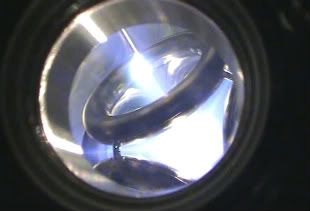There's something going on out in Santa Fe that may be of interest to you. Dr. Rick Nebel, on leave from Los Alamos National Lab, is working on a project for providing fusion power conceived by Dr. Robert Bussard. This project is known as the
Polywell, an idea Bussard was working on under a Navy contract prior to his death. Since that time, funding was restored for this phase of the project, and WB-7, their latest design, can be seen being tested here (using helium as fuel):

For a discussion forum where you can find Dr. Nebel himself, visit www.talk-polywell.org.
This is an internal electrostatic confinement (IEC) reactor. The devices are named WB-x for what is termed the "wiffle ball" effect. Here's part of how the Wiki describes its operation:
The polywell approach
Like the fusor, the polywell confines positive ions through their attraction to negatively charged electrons. The difference being that in the fusor, the negative charges reside on a solid-state grid. In the polywell, they are confined to the inner region of the reactor by magnetic fields. The reactor volume is defined by the coils producing the magnetic field, rather than by electrically charged grids. The advantage of coils over grids is that the magnetic fields produced by the coils also help protect them from the energetic electrons and ions. On the other hand, the polywell has electrons and ions existing in the same volume, reintroducing the Bremsstrahlung that the fusor can avoid.
The magnetic field is produced by a polyhedral arrangement of coils, all pointing toward (or all away from) the center. The magnetic field vanishes at the center, and the magnetic flux that enters the volume through the coils leaves it again through the spaces between the coils. Thus the electrons are confined to the central volume by a magnetic mirror with a large field ratio, and all the cusps are points (rather than lines). Ions can be added to produce a plasma, but there must always be more electrons than ions in order to maintain the potential well. While this concept, in contrast to the original fusor, uses magnetic fields, they do not need to confine nuclei � only electrons, which are orders of magnitude simpler to confine.
I've felt this project is of
vital importance ever since I learned about it. Why? Because, if the scaling laws hold to be true (Bussard calculated the fusion power output of the device scales as the seventh power of the radius, and the energy gain scales as the fifth power)
we will have fusion power.If that becomes the case, we can truly abandon fossil fuels and use what oil we have left for lubrication, firmly supplemented by and eventually supplanted by synthetics. We can finally supply clean, cheap, abundant, and reliable power to the entire planet. We can
finally tell Saudi Arabia and its Commission for the Promotion of Virtue and the Prevention of Vice to piss off, and
finally end war for oil. But most importantly, we can stop polluting our environment in our need for energy.
This project is definitely worth a look. If nothing else, they're doing some real, serious science, worthy of funding on the level of the Tokamak.